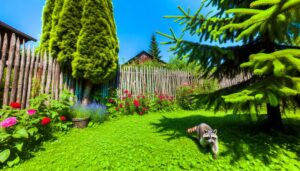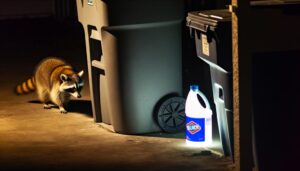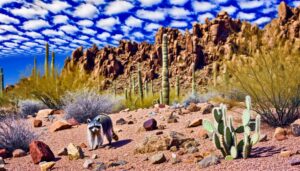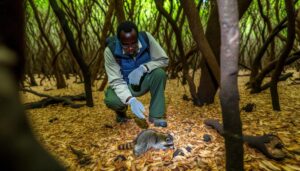Do You Get a Raccoon to Show Itself?
To encourage a raccoon to reveal itself, it is crucial to use attractants that cater to its diet and sensory capabilities. Offer food items like marshmallows, canned tuna, or peanut butter, and scent lures such as fish oil or vanilla extract.
Position these attractants near known raccoon hideouts—like hollow trees, attics, or dense vegetation—preferably at dusk when they begin foraging. Maintain a quiet, undisturbed environment and use passive observation tools such as binoculars or motion-activated cameras.
By setting up an inviting and safe space, you increase the chances of spotting a raccoon in its natural behavior. For further expertise, explore detailed methods.
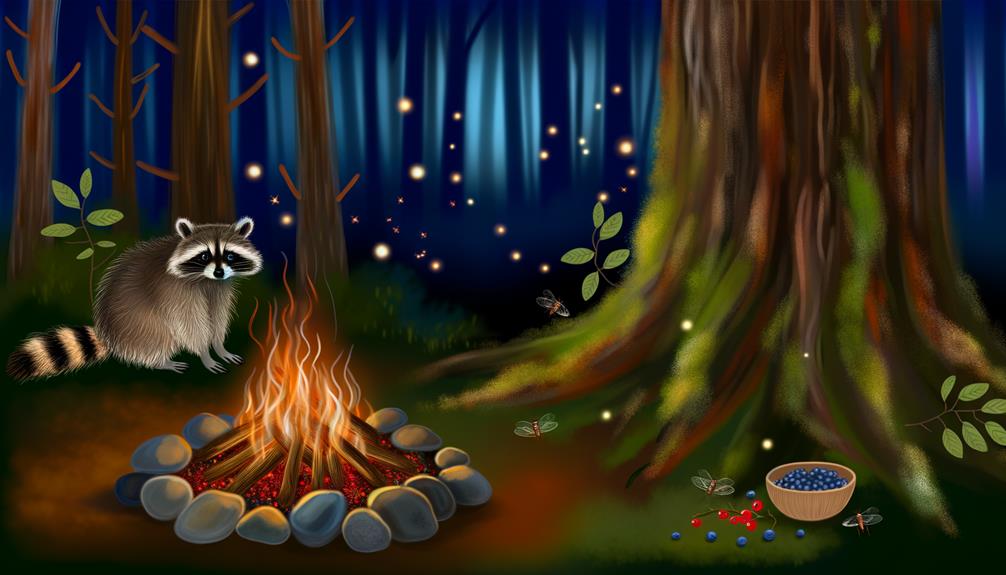
Key Takeaways
- Use food attractants like marshmallows, canned tuna, or peanut butter to lure raccoons.
- Set up reflective objects or shiny materials to catch raccoons' attention.
- Play nature sounds or raccoon calls to draw them out.
- Observe quietly from a distance using binoculars or motion-activated cameras.
- Schedule attractants and observation during dusk or dawn for better chances.
Understanding Raccoon Behavior
Raccoons (Procyon lotor) exhibit nocturnal behavior patterns, primarily emerging at dusk to forage for food and engage in social interactions. They possess highly developed sensory capabilities, including acute night vision and a keen sense of smell, which facilitate their foraging activities.
Typically, their diet consists of fruits, nuts, insects, small vertebrates, and human refuse, making them opportunistic omnivores. Socially, raccoons are often solitary but may form groups, especially females with their offspring.
Their activities are characterized by a combination of dexterous forepaws and remarkable problem-solving skills, enabling them to access a variety of food sources. Understanding these behaviors is essential for effectively locating and observing raccoons, as it informs the best times and methods for interaction.
Identifying Raccoon Habitats
To identify raccoon habitats, one must first recognize their common hideouts, such as hollow trees, abandoned burrows, and attics.
Observing signs of presence, like tracks, droppings, and disturbed trash, can further pinpoint their locations.
These indicators provide essential information for understanding and locating raccoon activity in various environments.
Common Raccoon Hideouts
In urban and suburban environments, one can frequently find raccoons taking refuge in attics, chimneys, and under decks, while in rural settings they often inhabit hollow trees, burrows, and dense vegetation near water sources.
These adaptable creatures exhibit a preference for locations that offer both safety and proximity to food sources. Urban raccoons are particularly adept at exploiting human structures, utilizing gaps or vulnerabilities in buildings to establish dens. Conversely, in rural areas, raccoons select natural shelters that provide concealment from predators and environmental elements.
Understanding these common hideouts is essential for those aiming to manage or observe raccoon populations, facilitating targeted strategies for humane trapping, relocation, or simply coexistence in shared environments.
Signs of Presence
Frequently, indicators such as overturned garbage cans, scattered food waste, and distinctive paw prints can reveal the presence of raccoons in a given area. Additionally, raccoons often leave behind other signs that can help in identifying their habitats. These include gnawed plants, damaged structures, and specific latrine sites where they defecate repeatedly. To aid in the identification of raccoon presence, the following table summarizes common signs and their descriptions:
| Sign | Description |
|---|---|
| Overturned Garbage | Cans knocked over, contents scattered |
| Paw Prints | Small, hand-like prints in mud or soft soil |
| Gnawed Plants | Evidence of chewing on garden vegetation |
| Latrine Sites | Concentrated areas of raccoon feces |
Accurately identifying these signs can assist in confirming raccoon activity, thereby facilitating appropriate measures for management.
Using Attractants
One effective method for enticing raccoons to reveal themselves involves the strategic use of attractants. These can include specific types of food, scents, and auditory cues. Raccoons are omnivorous and have a keen sense of smell and hearing, making them highly responsive to various attractants.
Food Attractants: Items like marshmallows, canned tuna, and peanut butter are particularly effective.
Scent Attractants: Commercial raccoon lures, fish oil, or even vanilla extract can be used.
Auditory Cues: Softly playing raccoon sounds or other nature sounds can draw their attention.
Visual Lures: Reflective objects or shiny materials can pique curiosity.
Timing: Setting attractants during dusk or dawn, when raccoons are most active, increases success.
These attractants can markedly improve the likelihood of a raccoon revealing its presence.
Setting Up a Safe Environment
Ensuring a safe environment is vital for both the observer and the raccoon, minimizing stress and potential hazards during observation or interaction.
A raccoon's habitat should be free from harmful substances and debris that could cause injury. Clear any potentially dangerous items such as broken glass or sharp objects. Additionally, avoid using toxic chemicals or pesticides in the vicinity.
For the observer, maintaining a safe distance is crucial; raccoons can become defensive if they feel threatened. Utilize non-intrusive methods like binoculars or motion-activated cameras to observe from a distance.
Providing a natural, undisturbed setting enhances the likelihood of a raccoon appearing, as they are more likely to venture into areas where they feel secure and unthreatened.
Observing Nocturnal Activity
Monitoring nocturnal activity is essential for understanding raccoon behavior, as these animals are mainly active during the night. Observing their nocturnal habits can provide insights into their feeding patterns, social interactions, and territorial behaviors.
Here are key practices to take into account:
- Quiet Observation: Minimize noise to avoid startling the raccoons.
- Natural Light: Utilize moonlight or low-intensity red lights, which are less likely to disturb them.
- Patience: Allow ample time for raccoons to emerge and engage in natural behaviors.
- Scent Control: Avoid strong scents that could deter raccoons from approaching.
- Safe Distance: Maintain a respectful distance to ensure both observer and animal safety.
These practices facilitate an ethical and effective approach to studying raccoons in their natural nocturnal environment.
Utilizing Technology
Integrating technology into raccoon observation can greatly enhance the accuracy and depth of behavioral studies. Advanced tools such as infrared cameras and motion sensors enable researchers to monitor nocturnal activities without disturbing the animals. These devices can capture high-resolution footage in low-light conditions, providing invaluable insights into raccoon behavior and interactions.
Additionally, GPS collars can be utilized to track movement patterns over large areas, revealing critical data on habitat use and range. By employing these technologies, wildlife professionals can better understand raccoon ecology, ultimately aiding in the development of more effective conservation strategies. These technological advancements not only enhance scientific research but also serve to promote the well-being and protection of raccoon populations.
Conclusion
To sum up, grasping raccoon behavior, pinpointing their habitats, and utilizing attractants are vital for enticing raccoons to show themselves.
Establishing a secure setting and monitoring their nighttime actions additionally boost the chances of sightings.
Employing technology like night-vision cameras improves observation precision.
It is noteworthy that raccoons are mainly active at night, with research indicating that 80% of their behavior takes place during nighttime, making evening hours the best time for observation.
Such information highlights the significance of timing and surroundings in examining raccoons.

